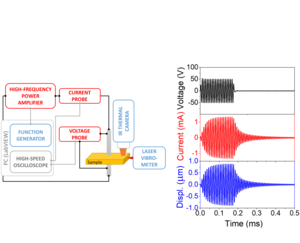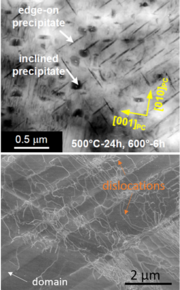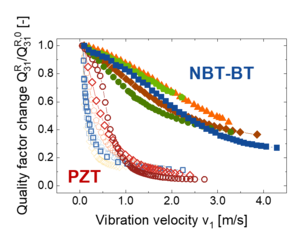Piezoelectrics
Piezoelectrics enable the conversion of electrical signals into mechanical ones, and vice versa. Hard-type piezoelectric materials are characterized by low losses and a stable high-frequency response. These are increasingly used in high-power applications, such as ultrasonic cleaning, ultrasonic welding, voltage transformers, and miniaturized ultrasonic motors. While the state-of-the-art lead-based piezoelectrics are hitting their limits in operating temperature and maximal vibration velocity, several new and environmentally-friendly lead-free alternatives have emerged recently. In particular, acceptor-doped compositions and composites of the Na1/2Bi1/2TiO3 family have demonstrated excellent high-power stability and increased depolarization temperatures. Our goal is to develop new materials and the necessary measurement methodology.
Laboratory for high-power piezoelectrics
Our group runs a laboratory dedicated to the investigation of piezoelectrics at resonance conditions, including small-signal and high-power measurements. We established a method for in situ characterization of piezoceramics at high frequencies, which enables to simultaneously investigate microscopic and macroscopic parameters of the sample, while being driven at resonance conditions. More recently, we developed a method for investigation of piezoceramics under combined AC and high-voltage DC loads.
Details on measurement capabilities are listed in publications:
SLABKI, Mihail, WU, Jianing, WEBER, Michael, BRECKNER, Patrick, ISAIA, Daniel, KENTARO, Nakamura, KORUZA, Jurij. Anisotropy of the high-power piezoelectric properties of Pb(Zr,Ti)O3. Journal of the American Ceramic Society, 2019, vol. 102, 6008-6016.
SLABKI, Mihail, VENKATARAMAN, Lalitha K., CHECCHIA, Stefano, FULANOVIĆ, Lovro, DANIELS, John, KORUZA, Jurij. Direct observation of domain wall motion and lattice strain dynamics in ferroelectrics under high-power resonance. Physical Review B, 2021, vol. 103, 174113.
KOS, Tomaž, SLABKI, Mihail, PETROVČIČ, Janko, VRANČIĆ, Damir, DOLANC, Gregor, KORUZA, Jurij. Measurement system for piezoelectric resonance impedance spectroscopy under combined AC and high-voltage DC loading. IEEE Transactions on Ultrasonics, Ferroelectrics, and Frequency Control, 2022, vol. 69, No. 11, 3137-3244.
Piezoceramic properties can be decisively influenced by microstructural elements, such as grain size, secondary phases, porosity, dislocations, etc. Together with collaborators, we demonstrated that dislocations can be used to pin domain walls at low electric fields and induce a macroscopic restoring force at large fields, which results in large increase of the piezoelectric coefficients. Moreover, we co-developed two new groups of hard-type piezoceramics: composites with semiconducting secondary phases (composite hardening) and ferroelectrics with fine intragranular inclusions of the secondary-phase (precipitate hardening). These microstructural elements are more stable at elevated temperatures and vibration velocities, as compared to point defects.
HÖFLING, Marion, ZHOU, Xiandong, RIEMER, Lukas M., BRUDER, Enrico, LIU, Binzhi, ZHOU, Lin, GROSZEWICZ, Pedro. B., ZHOU, Fangping, XU, Bai-Xiang, DURST, Karsten, TAN, Xiaoli, DAMJANOVIC, Dragan, KORUZA, Jurij*, RÖDEL, Jürgen*. Control of polarization in bulk ferroelectrics by mechanical dislocation imprint. (* corresponding authors) Science, 2021, vol. 372, 961-964.
ZHAO, Changhao, GAO, Shuang, YANG, Tiannan, SCHERER, Michael, SCHULTHEISS, Jan, MEIER, Dennis, TAN, Xiaoli, KLEEBE, Hans-Joachim, CHEN, Long-Qing, KORUZA, Jurij*, RÖDEL, Jürgen*. (* corresponding authors) Precipitation Hardening in Ferroelectric Ceramics. Advanced Materials, 2021, vol. 33, 2102421.
LALITHA, Venkataraman, RIEMER, Lukas M., KORUZA, Jurij, RÖDEL, Jürgen. Hardening of electromechanical properties in piezoceramics using a composite approach. Applied Physics Letters, 2017, vol. 111, 022905.
Introduction of point defects by chemical doping is a common approach to tune the properties of electroceramics, yet the underlying mechanisms and the relation to the electronic structure are often unknown. Our aim is to experimentally explore and quantify how co-doping (simultaneous doping with acceptor and donor ions) influences the electronic structure and Fermi level and in turn the electromechanical, microstructural and transport properties of piezoelectric perovskite ceramics. The results will ultimately result in guidelines for Fermi level engineering of piezoelectrics. This work is being carried out within the Collaborative research center SFB 1548 "FLAIR".
We investigated the origin of increased losses in piezoelectrics at high-power resonance drive and confirmed it to be related to increased domain wall vibration. The smaller amount of domain wall contribution in lead-free (Na1/2Bi1/2)TiO3-based materials, as compared to Pb(Zr,Ti)O3, result in lower losses in the former materials and thus more stable high-power behavior.
SLABKI, Mihail, VENKATARAMAN, Lalitha K., CHECCHIA, Stefano, FULANOVIĆ, Lovro, DANIELS, John, KORUZA, Jurij. Direct observation of domain wall motion and lattice strain dynamics in ferroelectrics under high-power resonance. Physical Review B, 2021, vol. 103, 174113.
SLABKI, Mihail, LALITHA, K.V., RÖDEL, Jürgen, KORUZA, Jurij. Origin of high-power drive stability in Na1/2Bi1/2TiO3-BaTiO3 based piezoceramics. Acta Materialia, 2022, vol. 227, 117703.
Assoc. Prof. Dr. Jurij Koruza
Institute for Chemistry and Technology of Materials
Stremayrgasse 9
A-8010 Graz
Phone: +43 (0)316 873-32305
jurij.koruza@tugraz.at


DFG Research Grant 414073759
DFG/FWF SFB 1548 "FLAIR"
Athene Young Investigator Research Support (TU Darmstadt)



